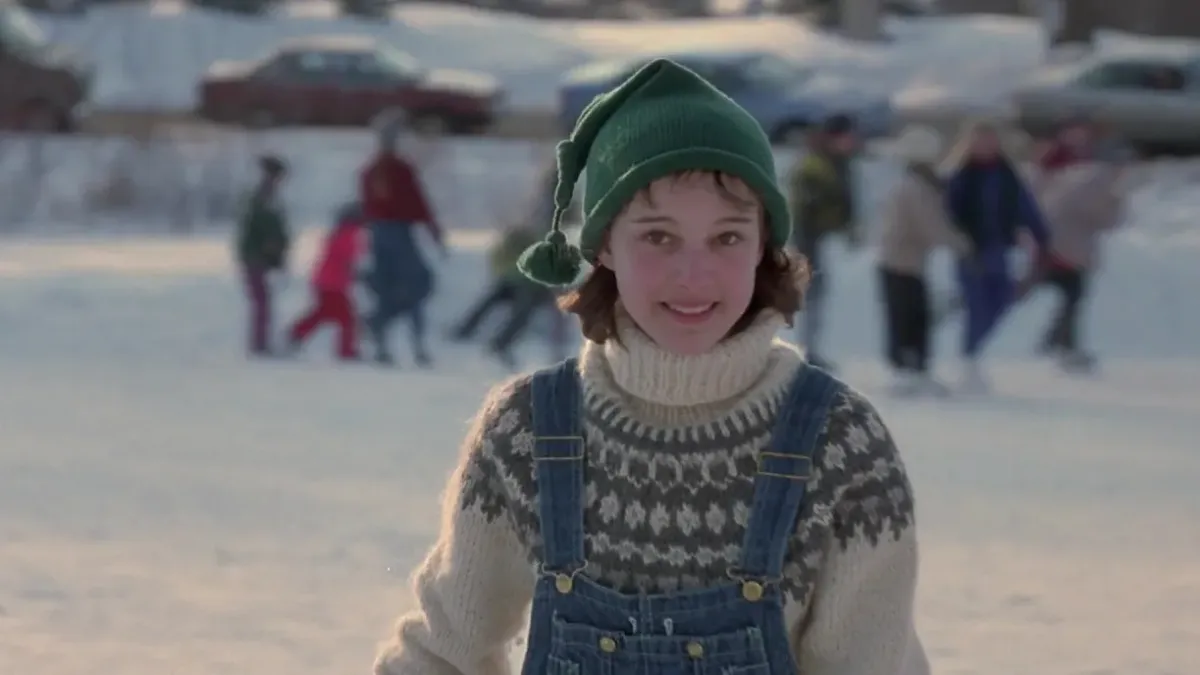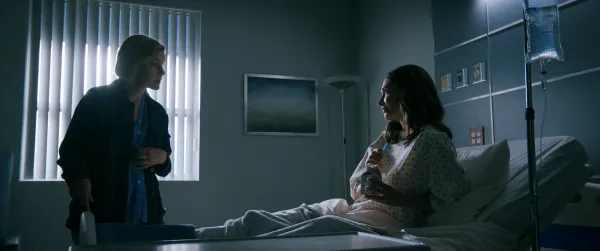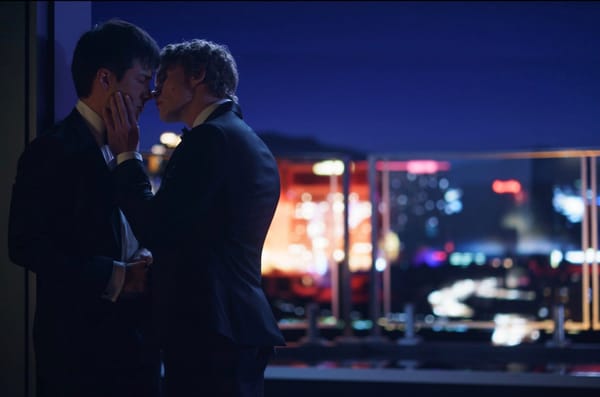Kirsten and Natalie #2: Little Women (1994) and Beautiful Girls (1996)
The movies and precocious girl children, explained.

(Kirsten and Natalie is a series tracing American womanhood as portrayed through the films of Kirsten Dunst and Natalie Portman. Read the introductory post here.)
Fiction is full of girls who are wise beyond their years. It has far fewer girls who are little pieces of shit. Amy March of Little Women (played by Kirsten Dunst in Gillian Armstrong's 1994 adaptation) is both, because her progenitor was Louisa May Alcott. Alcott perfectly understood that the line between "girl who is wise beyond her years" and "little piece of shit" is very ill-defined indeed.
Marty, the 13-year-old girl played by Natalie Portman in Ted Demme's Beautiful Girls, is wise beyond her years in a way that feels like creepy wish fulfillment. She doesn't talk like a person; she talks like a movie character. But that's the fate of all the women in Beautiful Girls, a movie that thinks it's making a point by giving its core fivesome of dudes a lot of naturalistic dialogue about how they love turning women into objects to attain. Yet every time the movie has a chance to turn a scene over to the women within it, they feel like they've wandered in from a "how to write women" class at a screenwriting seminar.
I did not like Beautiful Girls. I had seen it shortly after it came out on video in the 1990s, and I remember liking it then (because I wanted so badly to be like Marty, of course). But watching it in 2022 is an exercise in realizing just how much we genuinely have rethought specific ideas about gender politics in the intervening 25 years. We haven't come far, but we've come at least a couple of blocks.
(Hilariously, Yahoo marked the 25th anniversary of the movie's release last year by writing about how its treatment of the Marty character is creepy. It feels peculiar to me that we're now writing "Did you know this obscure 1996 comedy produced by Harvey Weinstein has some problematic elements in it?" articles. I guess we've run out of other "did you know [x] is problematic" topics.)
I did like the 1994 Little Women, both then and now. Indeed, it's probably my favorite feature film adaptation of Alcott's book. (Yes, I prefer it to the 2019 edition.) A good Little Women adaptation captures the core appeal of the tale, which is the idea that there is a big, warm house somewhere that will always accept you as you are, and for me, Armstrong's film captures that notion best. (Armstrong, however, doesn't have Bob Odenkirk saying, "My little women," so points off for that.)

Yet the larger project of Kirsten and Natalie isn't to catalog which 1990s movies "hold up." It's to look at these films through the prism of Kirsten Dunst and Natalie Portman, two actors whose work I glommed onto as a young trans girl trying to figure out how to womanhood. And Little Women and Beautiful Girls are the first movies in this series that I imprinted upon. And though I prefer Little Women as a piece of filmmaking (it might sneak into my top 100 films of all time), Beautiful Girls is far more fascinating to view through this prism.
As I mentioned in the first installment of Kirsten and Natalie, "Natalie Portman sure is a good-looking child" became a subgenre of film in the mid-1990s. The movies that featured her as an object of sexual curiosity on the part of an adult man involved in some capacity men who have been credibly accused (and sometimes convicted) of sexual offenses. For example, Luc Besson directed Léon: The Professional, while Harvey Weinstein produced and Timothy Hutton starred in Beautiful Girls.
Léon gets away with its fetishization of Portman in a way Beautiful Girls does not. Whatever you might say about Matilda in Léon, her character is very much of a piece with the movie's whole deal. Marty in Beautiful Girls is a gross male fantasy, and I'm not sure how much the film understands what it's doing when it comes to her character. Matilda's crush on Léon is motivated by how little else she has in the world. He's become her whole universe, and that has gotten wrapped up in her sexual awakening. Marty's crush on Willie Conway (Hutton), a jazz pianist home for his high school reunion (being held in winter for some reason), exists because the screenplay needs it to.
The film never seriously feints toward getting Willie and Marty together. He gets jealous of her 12-year-old boyfriend, and she is pretty frank about her crush on him. But when he haltingly suggests that maybe he could wait five years for her to come of age to a friend, his friend is, like, "You're dating 1990s Annabeth Gish. What are you doing thinking about a 13-year-old?" Beautiful Girls doesn't once seriously believe that Willie and Marty can have a successful romantic relationship.
But it does believe the two can both be bettered by having crushes on each other. And that's where the movie flies off the rails.
In contrast, Little Women exists in a kind of anti-patriarchal utopia, like a family-friendly version of Celine Sciamma's Portrait of a Lady on Fire or something. The March house in this film is such a matriarchy that Mr. March only pops in for the one famous scene featuring him (the one where he comes home for Christmas), before shuffling into the background for his daughters' wedding and funeral.
The young Amy and Marty have little in common beyond existing in idyllic winterscapes, but the movies they're in treat them as possibilities more than personalities. Amy casts lines out in every direction across the first half of Little Women (the half Dunst is in). Her emotions seem to oscillate wildly not just because she's the youngest or because she's on the verge of adolescence. No, they wander all over the place because she is trying on different modes of being. This Amy is kind. This Amy is vengeful. This Amy is wise beyond her years.
When Amy grows into an adult (played here by Samantha Mathis), those possibilities have resolved into a person. Unfortunately, older Amy is a bore here, all propriety and chaste romance. The one area where the 2019 adaptation outshines the 1994 movie is in its presentation of an Amy who has run out of options to help her family. All of her older sisters have made choices that put her social standing in peril to some degree. She marries Laurie because she loves him; she loves him because she has to.
But the movie's critical understanding of Amy's childhood is that growing up in this house, surrounded by these sisters, with this mother, allowed her that possibility space. She could try on different versions of herself because when inside the March home, she existed outside the burden of men's expectations. Once she leaves the house, she is flattened into a woman whose potential rests primarily on whether she will marry an eligible suitor and bear him children. That fate is what awaits Amy in all adaptations of this story. Absent other options, she gets married.

Beautiful Girls filters Marty at all times through the perspective of Willie. We never see her independent of the way he looks at her. He encounters her outside in the snow. He watches her from the window of his father's home. He bumps into her at the ice skating rink. She does not exist outside of his gaze. She is not a web of possibilities; she is a singular possibility: Someday, she will grow up into Natalie Portman, and won't that be exciting?
To be fair to Beautiful Girls, it's trying to do this. Outside of a few scenes, the women in the film exist so the men may perceive them. The movie offers them a few tiny shreds of humanity, but even when it does that, the humanity is expressed in the general direction of a man. A scene where Rosie O'Donnell rants at two of the guys about the unrealistic appearance of Penthouse models, much acclaimed by critics at the time, drops into the movie out of nowhere. It exists mainly to underline a point the film has made better in other scenes: These guys don't have a realistic conception of women.
Marty's precocity exists in a similar sphere. I rarely ding movies for giving adolescents dialogue that seems beyond their vocabulary level. Teenagers have vast emotional worlds that they express mainly to each other. But even within my typically lenient standards for this sort of thing, Beautiful Girls made me cringe. Marty's intelligence is not treated as something that makes her a fun kid to talk to. It's treated as a sign of how you could maybe think of her as a romantic partner for Willie. She exists solely to prop him up as a character. He gets to learn a lesson; she gets to grow up into Natalie Portman. That's supposed to be comfort enough.
How does Marty feel about this now, in 2022, when she's 38? I don't expect anyone ever to revisit this character. But where Beautiful Girls creates a host of guy characters whose inner lives are vibrant enough to allow an audience to imagine the general arc of their lives, its women are permanently frozen in place. It's hard to imagine a 38-year-old Marty because it's hard to imagine what 13-year-old Marty gets up to when Willie isn't around. She isn't real. She's a fantasy. And because she's 13, she is a very specific fantasy of what it would be like to mold a beautiful woman from childhood to adulthood, so she only loved you.
That fantasy is not unique to Beautiful Girls. Beautiful Girls isn't even close to its creepiest expression in our culture. And I don't want to say the "precocious girl who can keep up with the adults" character type is a direct expression of this fantasy, but I do find it fascinating how much more frequently stories feature precocious teen girls instead of precocious teen boys. In many of these stories, they are tasked with caring for and nurturing adult men, even if those tasks never edge toward the romantic. In the world of the movies, a woman can go from a girl to a mother in moments. All that has to shift is how a man perceives her.
In high school, I had furtive make-out sessions with boys. Our assignations always left me frustrated, because they were not seeing me correctly. They were either deeply closeted gay men or even more deeply closeted bisexuals. The point is that they never saw me as the person I wanted them to see me as, which is to say: a girl.
Then one summer at camp, I met a boy I'll call Louis. We hit it off, and one night, we went back to his dorm room (this camp was at a college campus), ostensibly so he could show me some of his CDs. We did some kissing, and somewhere in the middle of our making out, a switch clearly flipped in his brain. Something became more tender and insistent in the way he treated me, and I understood that he saw me for who I was, even if he didn't realize that. Finally, I was being seen by a boy I was romantically interested in. It felt like nothing else.
Throughout my life, men would see me as a fellow queer man, but the irony was that I desperately wanted them to see me as a straight girl. I couldn't escape the shadow of their misperception. On the other hand, women of all sexualities seemed to instantly intuit the truth about me, even if they couldn't put words to it. I came out to one of them late in high school, not because I chose to but because she guessed. At the moment, I felt relief.
But what I wanted was for someone to see me as Louis did for those few minutes. Even Louis was incapable of doing so beyond whatever happened in that brief period. It became clear he had a crush on me; it also became clear he had a crush on the wrong version of me. I lost interest. Poor Louis. (A sidebar, tho: He later married a woman who looks exactly like me. I'm counting this as a win for my ego.)
Much of adolescence is figuring out ways of being seen. You want other people to know you for who you are, but you don't yet know yourself. You try on modes of being, and you hope that someone connecting with one of those modes will finally make sense of yourself. It is a constant, exhausting process of self-definition by trial and error, but you do find yourself somewhere at the end of it all.
I was caught in dual traps. One of those traps meant I could never accurately define myself because the handful of times I had tried to take charge of my identity had been met with violence and reprisal. But the other was the trap so many women attracted to men find themselves enmeshed in as teenagers: It can feel so good when a boy sees you that you give little bits and pieces of yourself away. When that boy is a peer, learning how to navigate that situation is part of growing up. But far too often, that boy isn't a peer. He's older. Sometimes substantially older.
We know the problems with that, or I like to think we do. But we still live in a world littered with cultural artifacts that insist something like the Willie and Marty flirtation can be something mostly harmless and cute. Beautiful Girls isn't a problem for presenting a story about a man and a girl who strike up a rapport that makes the audience feel queasy. No, it's a bad movie because it struggles to understand why we would feel queasy at all.

Programming note: I've started going by Emily St. James among friends, and I consider you all friends, so I'm going to start going by that name here, too. I promise that this will all make sense in time.
What I've been up to: Among the things I published over at Vox this week was a piece about colors in movie and TV and why everything is sort of dishwater brown now. Naturally, Zack Snyder fans got mad about it online.
If you watch a lot of movies and TV shows, you might have noticed that over the last few decades everything has gotten a lot more ... gray. No matter the kind of story being told, a sheen of cool blue or gray would wash over everything, muting the colors and providing an overall veneer of serious business. So many TV shows and movies now have a dull filter applied to every scene, one that cuts away vibrancy and trends toward a boring sameness. Every frame’s color scheme ends up feeling the same as every other frame. And when there are so many projects using similar techniques, you end up with a world of boring visuals that don’t stand out.
What you'll miss if you're not a subscriber to Episodes: Remember that next Monday will be the first of my Cowboy Bebop recaps, available only to subscribers. I'm so excited to dig into this series!
Read me: I've been working my way through Alex Pheby's Mordew, and it's a terrific twist on the fantasy novel. I was put on the trail of it by some friends and then this excellent LA Review of Books essay by Alexandra Marraccini, which examines the novel in the context of leftist reimaginings of British fantasy.
The elevation of British fantasy to literary heights that speculative fiction otherwise rarely sees was already a well-established trend by the time Potter fandom exploded. During the middle years of the 20th century, C. S. Lewis and J. R. R. Tolkien formalized a tradition for high fantasy to serve as an expression of quintessential Englishness, especially for American readers. This flavor of Englishness was intellectually and politically conservative: it idealized agrarianism, implicit racial bias, classicism, and anti-feminism. Nonetheless, it started an enduring trend: England would supply the coffee tables of the American chattering classes with new flavors of fantasy that stoked the imagination but never really made anyone truly uncomfortable. It’s all in all a very normative, very white, very bourgeois wardrobe to make a world in — yet it’s also one that provides a powerful scaffolding of compelling literary prose that can be reworked by its inheritors. As far as ossuaries go, midcentury British import fantasy is rich in grave goods.
Watch me: I have gotten super into YouTuber José's video essays on assorted American sitcoms. Of particular note is his latest one on Cheers, which I gobbled up with great enthusiasm.
And another thing... By now you've heard of Wordle, the weird little word game all of the world seems addicted to. But have you checked out Absurdle? It's a version of Wordle where the answer shifts with every new guess. You have unlimited guesses, so you can eventually get it, no matter how long it takes. I've found it incredibly fun.
Opening credits sequence of the week: I do not think I need to tell you that Booker aired in the 1989-90 TV season. I think you can watch the opening credits and figure that out for yourself.
A thing I had to look up: I spent a lot of time looking up contemporaneous reviews of Beautiful Girls, and it's kind of amazing how many of them are, like, "Yep! That's just how it is!" They're not wrong, but also...?
This week's reading music: "Locomotive Breath" by Jethro Tull (from the major motion picture Beautiful Girls)
Episodes is published twice per week. Mondays alternate between a free edition on various topics and a subscriber-supported edition where I recap TV shows of interest. Fridays offer pop culture thoughts from freelance writers. The Friday edition and the biweekly recaps are only available to subscribers. Suggest topics for future installments via email or on Twitter. Read more of my work at Vox.




